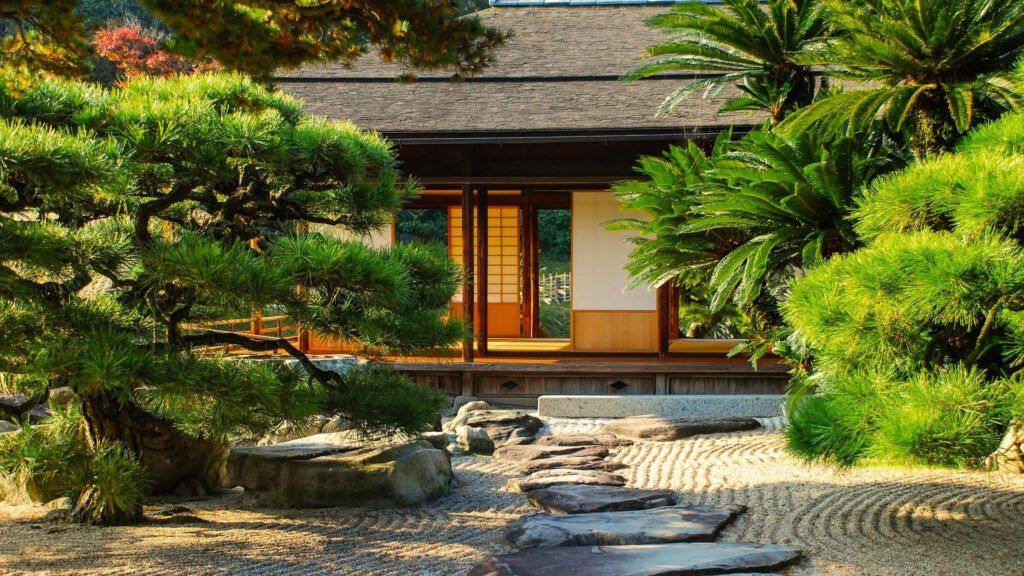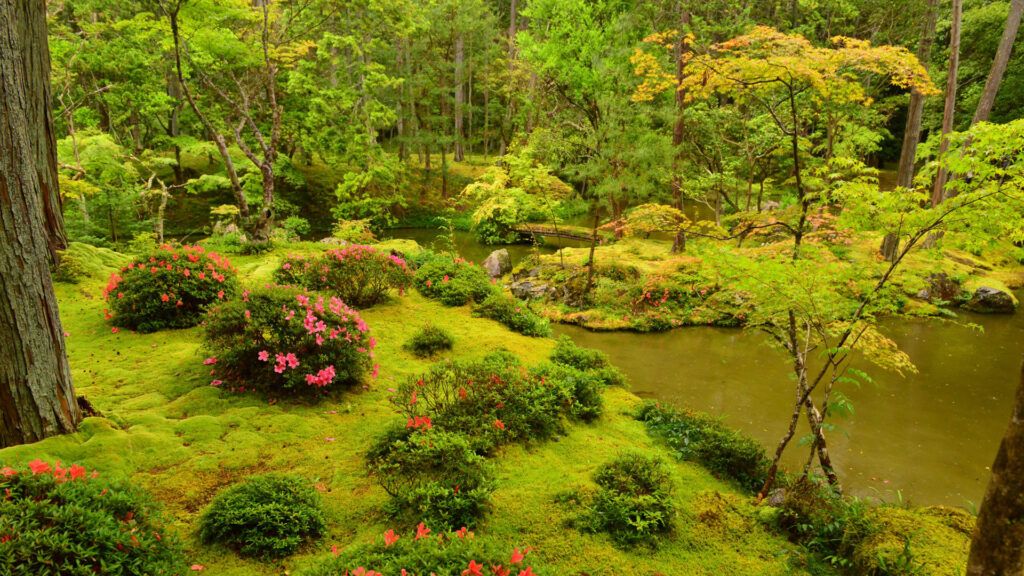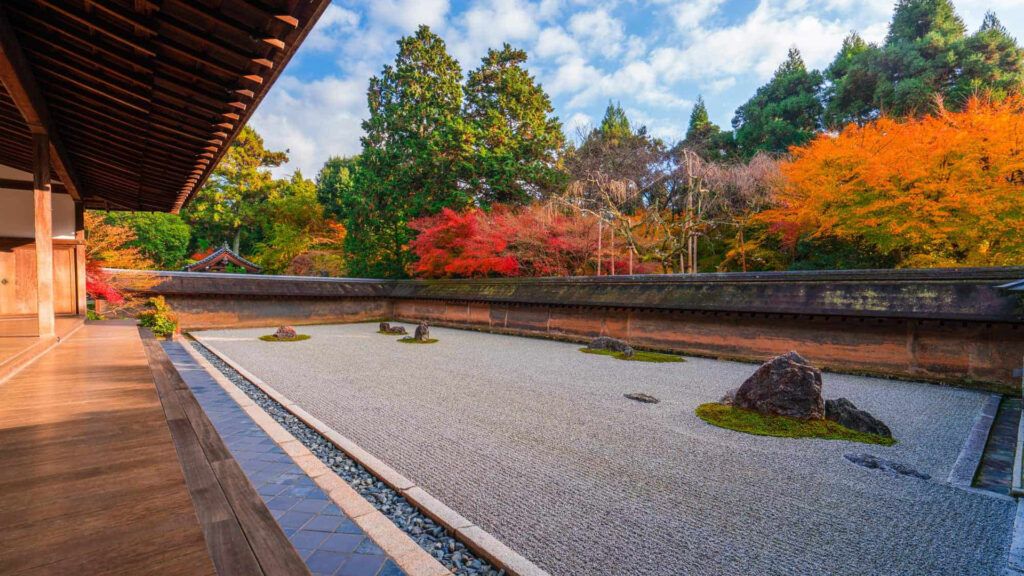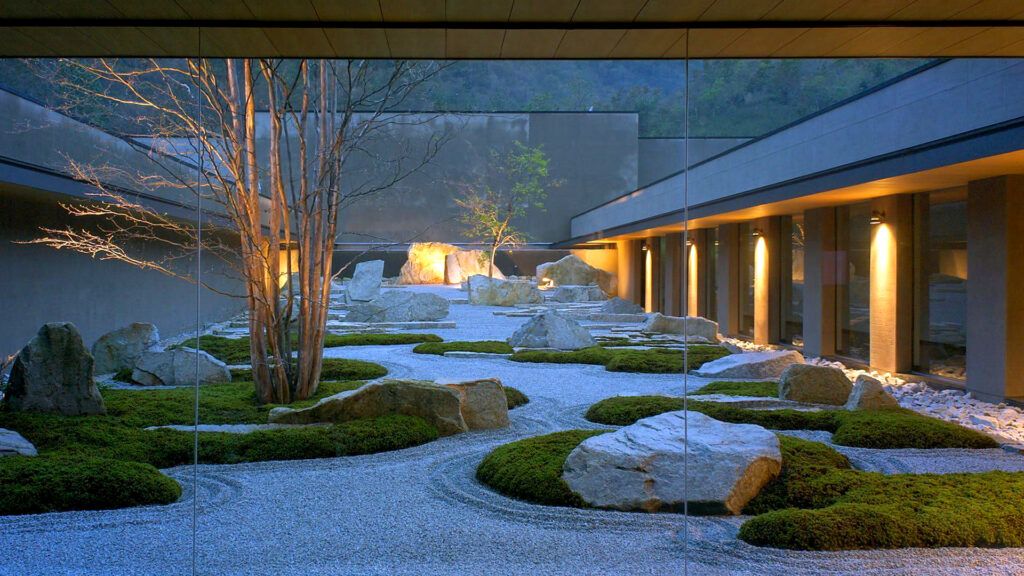
In Japanese garden design, there is a unique tradition that not only captures the outer beauty of nature but also conveys a deep spiritual meaning. Japanese garden design, influenced by Zen philosophy, embodies a harmonious fusion of nature, spirituality, and aesthetics. This art form, practiced for centuries, is much more than just arranging plants and stones. It is a reflection of Japanese culture, its values, and its profound respect for nature.
A Japanese garden is not just a space but an experience that engages the senses and touches the soul. The design of each element is carefully considered to create an atmosphere of tranquility and contemplation. Central to Japanese garden design is the concept of emptiness or space, allowing room for thoughts and feelings. This reflects the central teaching of Zen, which states that true enlightenment is found in the emptiness of the mind.
The selection and placement of elements in a Japanese garden follow specific principles based on the harmony between humans and nature. Stones, water, plants, and sand are carefully arranged to create a balanced composition that mimics natural landscapes while revealing abstract beauty. Every stone, tree, and pond is thoughtfully placed to achieve a harmonious balance and promote the flow of energy, known as Ki.
A key aspect of Japanese garden design is the use of symbols and metaphors to convey deeper meanings. A common motif is the dry or gravel garden, known as Karesansui, often arranged with carefully raked sand or gravel that mimics the waves of an ocean or the flow of a river. These minimalist gardens invite the viewer to sink into meditation and reflect on the flowing movement of life.
Another important element of Japanese gardens is tea houses, often hidden amidst lush vegetation. These modest structures serve as retreats for tea ceremonies, which hold deep spiritual significance. The simplicity and tranquility of a tea house harmonize perfectly with the surrounding nature, emphasizing the values of modesty, serenity, and appreciation of the moment.
Caring for a Japanese garden requires patience, precision, and a deep understanding of natural processes. Gardeners often spend hours cleaning stones, pruning plants, and raking sand to ensure that every aspect of the garden remains in perfect harmony. This dedication to craftsmanship and detail reflects the Japanese spirit of perfection and underscores the appreciation for beauty in the small things.
A Japanese garden is not only a place of aesthetic pleasure but also a place of spiritual renewal and inner reflection. Through conscious space and element design, it provides a retreat from the hustle and bustle of modern life, reminding us to appreciate the beauty and simplicity of nature. In a Japanese garden, we can find peace, draw inspiration, and establish a deeper connection to the world around us.
The fascination with Japanese garden design extends beyond the borders of Japan, inspiring people around the world. Its timeless beauty and spiritual teachings have a lasting impact on how we design gardens and experience nature. In a world often characterized by haste and noise, the Japanese garden offers a precious space of silence and contemplation, reminding us to appreciate the wonders of nature and live in harmony with it.
Japanese garden design is a living heritage that preserves the wisdom and beauty of past generations while also serving as a source of inspiration for the future. Its timeless elegance and profound teachings about the connection between humans and nature make it a treasure that will be cherished and admired forever. In a Japanese garden, we can not only admire the outer beauty of nature but also find the inner peace and harmony that connects us with the world around us.
Zen and Garden Architecture

The significance of Zen in Japanese garden architecture is crucial and permeates every aspect of design. Zen, a form of Buddhism, emphasizes the pursuit of enlightenment through meditation, mindfulness, and the quest for inner peace. This philosophy is reflected in the minimalist aesthetics and harmonious balance of Japanese gardens.
Zen teachings emphasize appreciation for the here and now, the beauty of simplicity, and the importance of mindful living. These principles are manifested in garden architecture through the use of clean lines, minimalist elements, and carefully selected details. A Japanese garden is not a place for excessive decorations or extravagant structures, but rather a space of purity and clarity that allows the viewer to focus on the essential and find inner peace.
Zen philosophy also calls for a close connection between humans and nature. This is reflected in how Japanese gardens mimic natural landscapes and invite the viewer to connect with the environment. By integrating water, stones, plants, and other natural elements, Japanese gardens create a harmonious environment that promotes the flow of energy and soothes the senses.
A central aspect of Zen is the idea of emptiness or space, allowing room for thoughts and feelings. This teaching is found in the design of dry or gravel gardens, which often contain vast expanses of raked sand or gravel, mimicking the vastness of the ocean or the silence of the desert. These minimalist landscapes invite the viewer to deepen their meditation and explore the emptiness of the mind.
The practice of Zen meditation is also reflected in the care and maintenance of Japanese gardens. Gardeners often spend hours cleaning the stones, pruning the plants, and raking the sand, fully focusing on the present task and freeing themselves from distracting thoughts. This meditative practice not only creates beautiful gardens but also fosters a sense of serenity and inner peace in those who tend to them and enjoy them.
Overall, the integration of Zen principles into Japanese garden architecture provides a unique opportunity to deepen the connection between humans and nature and create a space of tranquility and contemplation. This timeless art form invites one to retreat from the hustle and bustle of everyday life, calm the mind, and develop a deeper appreciation for the beauty and harmony of nature.
Wabi-Sabi and Garden Architecture

Wabi-Sabi is an aesthetic concept that also holds significant influence in garden architecture. To understand the essence of Wabi-Sabi, we must first examine its fundamental principles. Wabi refers to simplicity, modesty, and the beauty of imperfection. It is the beauty found in simplicity and restraint. Sabi, on the other hand, describes an appreciation for the aged, the patina, and the transience of things. It is the beauty that emerges through the passage of time and the effects of nature. Together, Wabi and Sabi form a philosophy that recognizes beauty in the understated, the ephemeral, and the imperfect.
In Japanese garden architecture, the concept of Wabi-Sabi is manifested in various ways. One significant aspect is the selection of materials. Natural stone, wood, and moss are typical elements used in Japanese gardens, developing a natural patina that aligns with the concept of Sabi. These materials are often left in their natural forms, without excessive manipulation or perfection, to emphasize the beauty of imperfection.
Another feature of Japanese gardens closely associated with Wabi-Sabi is the emphasis on simplicity and restraint in design. Instead of elaborate ornaments or intricate structures, clear lines and minimalist arrangements are preferred. This simplicity invites appreciation of the natural surroundings and subtle details, rather than being distracted by ornate elements.
A central element of many Japanese gardens is water, serving both as a design element and a symbol of tranquility and renewal. Ponds, streams, and waterfalls are arranged to mimic natural movements and forms. The play of light and shadow on the water’s surface, along with the gentle trickling, contributes to the meditative atmosphere of the garden and emphasizes the transience of the moment, another concept associated with Sabi.
The arrangement of stones in Japanese gardens is another way to illustrate the principle of Wabi-Sabi. Instead of perfectly symmetrical formations, stones are often arranged in irregular groups to create a natural, organic atmosphere. These arrangements often symbolize mountain landscapes or other natural formations, inviting the viewer to find their own interpretation and establish a connection with nature.
Another important aspect of Japanese garden architecture closely linked with Wabi-Sabi is the emphasis on seasons and the changing of nature. By selecting plants and materials that change and evolve throughout the year, the transience and beauty of the moment are highlighted. This concept, known as “Shun,” encourages observing and appreciating the changes in nature rather than clinging to past beauty.
Overall, Japanese garden architecture impressively demonstrates how the concept of Wabi-Sabi can be integrated into the design of outdoor spaces. By emphasizing simplicity, modesty, transience, and the beauty of imperfection, Japanese gardens create an atmosphere of peace, harmony, and connection with nature. They invite pause, discovery of beauty in the understated, and deeper connection to the natural world.
An outstanding example of applying Wabi-Sabi in Japanese garden architecture is the famous Ryoanji Temple Garden in Kyoto. This Zen garden consists of a dry gravel bed with fifteen carefully placed stones. Although the garden appears very simple, it holds deep symbolic meaning and encourages meditation and reflection. The irregular arrangement of the stones and the empty spaces in the gravel bed allow room for interpretation, enabling each viewer to find their own meaning.
The Ryoanji Temple Garden perfectly embodies the principles of Wabi-Sabi by showcasing the beauty in imperfection and transience. The careful selection of stones, their placement in the garden, and how they interact with the surrounding space create an atmosphere of tranquility and contemplation. This garden is an inspiring example of how Japanese garden architecture captures the essence of Wabi-Sabi and expresses it in subtle and powerful ways.
In addition to the Ryoanji Temple Garden, there are many other impressive examples of Japanese gardens embodying the principles of Wabi-Sabi. The Katsura Imperial Villa Garden in Kyoto is another outstanding example of using natural materials, minimalist design, and emphasizing the seasons. This garden, created in the 17th century, is a masterpiece of landscape architecture, inviting visitors to experience the beauty of nature in its purest form.
Another notable example is the Adachi Museum of Art Garden in Shimane. This modern garden, created in the 1970s, combines traditional Japanese landscape design with contemporary architecture. Through careful selection of plants, stones, and water features, the garden creates a harmonious environment that embodies the principles of Wabi-Sabi in a contemporary manner.
An essential feature of many Japanese gardens is the integration of tea houses or tea pavilions. These structures serve not only as places of rest and contemplation but are also closely associated with the Japanese tea ceremony, a ritual that emphasizes the beauty of the moment and appreciation of the simple. The tea pavilions are often designed to harmonize with the surrounding landscape, creating an atmosphere of modesty and serenity.
Another important aspect of Japanese garden architecture associated with Wabi-Sabi is the idea of “Ma,” which means “empty space” or “the in-between.” This concept emphasizes the importance of space and silence in the design of gardens and other spaces. By consciously utilizing empty spaces and open areas, the natural beauty of the surroundings is highlighted, creating an atmosphere of tranquility and balance.
It is fascinating to observe how the principles of Wabi-Sabi are expressed not only in the design of gardens but also in other areas of Japanese art and culture. From traditional ceramics and Ikebana to contemporary architecture and art, elements of simplicity, modesty, and the beauty of imperfection are repeatedly found.
Japanese garden architecture provides a rich source of inspiration for designers, architects, and garden enthusiasts worldwide. Its emphasis on nature, simplicity, and transience reminds us to appreciate the beauty in the everyday and establish a deeper connection with nature. By integrating Wabi-Sabi into our own living spaces, we can create an atmosphere of peace and harmony, aligning ourselves with the timeless principles of Japanese aesthetics.
Famous Japanese garden architects

The history of Japanese garden architecture is rich with masters of their craft who have created significant works over the centuries. These artists have not only shaped the landscapes of Japan but also the way we design gardens and experience nature. Their works are expressions of beauty, harmony, and a deep connection with nature.
One of the most renowned Japanese garden architects is Kobori Enshu (1579-1647), a samurai, tea master, and garden master. Enshu was a polymath, excelling in various fields such as tea ceremonies, calligraphy, and architecture. His gardens are characterized by subtle elegance and careful composition, reflecting the principles of Zen. Enshu’s works, including the Katsura Rikyu Palace Garden in Kyoto, have had a lasting impact on Japanese garden art.
Another significant garden architect is Mirei Shigemori (1896-1975), considered a pioneer of modern Japanese garden design. Shigemori was known for his innovative approach to traditional garden styles and his experiments with abstract forms and materials. His works, such as the garden of Tofuku-ji Temple in Kyoto, demonstrate a bold combination of tradition and modernity and have a profound influence on contemporary garden architecture.
Another prominent name is Kinsaku Nakane (1917-2004), a master of landscape design known for his refined compositions and sensitive use of natural materials. Nakane was a disciple of Mirei Shigemori and carried on his legacy by blending traditional styles with modern innovations. His gardens, like the Ryoan-ji Temple Garden in Kyoto, are masterpieces of simplicity and austerity, radiating timeless beauty.
In addition to these outstanding individual artists, there are also entire families of garden architects who have perfected their craft over generations. An example is the Ogawa family, whose members have been renowned experts in landscape design since the 17th century. From Ogawa Jihei the First, considered the founder of modern Japanese gardening, to his descendants who carry on his legacy, the Ogawas have created a series of iconic gardens admired to this day.
In the contemporary era, new talents have emerged who continue the tradition of Japanese garden architecture in innovative ways. One such rising star is Fumiaki Takano, known for his avant-garde designs and experimental use of materials. Takano’s works, such as the garden of the Nezu Museum in Tokyo, break with conventional notions and explore new avenues of aesthetic expression.
The world of Japanese garden architecture is a fascinating interplay of tradition and innovation, where talented artists across generations push the boundaries of design and explore new avenues of aesthetic beauty. Their works are not only expressions of craftsmanship but also of a deep spiritual connection with nature and an unwavering dedication to the pursuit of beauty and harmony.
Local Differences in Japanese Garden Architecture

Japanese garden architecture is known for its diversity and regional variations, which are attributed to different climatic conditions, landscapes, and cultural traditions. These local differences contribute to each garden having a unique atmosphere and aesthetic closely tied to its surroundings and history.
In Kyoto, the ancient capital of Japan and a center of traditional culture, some of the country’s most renowned and beautiful gardens can be found. These gardens often feature a classical aesthetic ranging from the elegant temple tea gardens to the opulent palace gardens of the emperors. An example is the Katsura Rikyu Palace Garden, renowned for its careful composition and subtle elegance. Here, elements like ponds, bridges, and pavilions are arranged in harmonious balance, reflecting the principles of Zen and creating an atmosphere of tranquility and contemplation.
In Kanazawa, a city on Japan’s west coast, gardens influenced by the rich culture and heritage of the samurai can be found. These gardens are often surrounded by tall stone walls and are characterized by lush vegetation and elaborate water features. A notable example is the Kenrokuen Garden, one of Japan’s three most famous landscape gardens. Established in the 17th century, this garden offers breathtaking views of the surrounding landscape and is famous for its seasonal changes, including cherry blossoms in spring and colorful maple leaves in autumn.
In Okayama, a city in the Chugoku region, gardens known for their artistic refinement and romantic atmosphere can be found. Here, gardens like the Korakuen Garden are celebrated, regarded as one of Japan’s three most beautiful gardens. Established in the 17th century by a feudal lord, this garden offers picturesque views of an artificial hill, a pond, and a traditional tea house. Korakuen is known for its meticulous composition and elaborate water features, providing an idyllic setting for strolls and meditation.
In Shimane Prefecture, a rural region in southwestern Japan, gardens influenced by the wild beauty of nature and the mystical atmosphere of ancient legends can be found. Gardens like the Adachi Museum Garden, considered one of Japan’s most beautiful, are located here. Established in the 20th century by a wealthy businessman, this garden offers a stunning backdrop of lush vegetation, clear ponds, and elaborate stone arrangements. The Adachi Museum Garden is renowned for its meticulous care and constant evolution, making it a living work of art.
In Hokkaido Prefecture, a vast and sparsely populated region in northern Japan, gardens inspired by the rugged and untouched nature of the country can be found. Gardens like the Hokkaido Garden are distinguished by their careful composition and natural beauty. Established in the 19th century by a local landowner, this garden offers picturesque views of a rich diversity of plants and animals native to Hokkaido’s wild landscape. The Hokkaido Garden is a place of peace and relaxation, inviting visitors to enjoy the beauty and tranquility of nature.
In every region of Japan, unique gardens influenced by local traditions, landscapes, and cultural influences can be found. These gardens are not only places of beauty and relaxation but also reflections of the history and identity of their surroundings. By honoring local culture and nature, these gardens contribute to preserving and celebrating the unique diversity and beauty of Japan.
Japanese Moss Gardens

Moss gardens are a fascinating and unique form of Japanese garden art, distinguished by their use of moss as a primary element. These gardens, also known as Koke-Dera, are often imbued with a mysterious atmosphere, radiating deep tranquility and serenity. The use of moss in garden architecture has a long tradition in Japan, dating back to the 14th century when moss gardens were first created within temple grounds.
Moss holds special significance in Japanese culture, often associated with purity, freshness, and permanence. In garden art, moss is frequently used as a symbol of calmness and peace, serving to establish a harmonious connection between humans and nature. Moss gardens often serve as places for meditation and retreat, inviting individuals to leave behind the hustle and bustle of daily life and immerse themselves in the quietude of nature.
Designing a moss garden requires careful planning and a thorough understanding of the specific needs of mosses. These plants thrive in moist and shady environments, flourishing best in humus-rich soils. To create a moss garden, suitable locations must be selected, and special care practices implemented to provide optimal growth conditions.
A characteristic feature of moss gardens is their natural and organic aesthetic, often characterized by irregular shapes and gentle curves. The use of moss as ground cover creates a soft and inviting texture, blanketing the garden with a carpet of vibrant green. Stones, tree stumps, and other natural elements are commonly integrated into the design to create a natural and harmonious composition.
Moss gardens also serve as hubs of biodiversity and ecological balance, harboring a variety of microorganisms, insects, and other organisms. The dense root network of mosses serves as a habitat and food source for various species, contributing to the preservation of biological diversity. By protecting and promoting moss gardens, gardeners make a significant contribution to nature conservation and environmental preservation.
A well-known example of a moss garden is the Saiho-ji Temple Garden in Kyoto, also known as the “Moss Temple.” Established in the 14th century, this garden is famous for its lush moss landscapes and tranquil, meditative atmosphere. Visitors can wander through winding paths covered by a dense carpet of moss, experiencing the peaceful beauty of nature in its purest form.
Overall, moss gardens represent a unique and fascinating element of Japanese garden architecture, offering a deep connection to nature and a spiritual dimension. These gardens invite individuals to experience the healing power of nature and develop a deeper appreciation for the beauty and diversity of life. With their serene and meditative atmosphere, moss gardens provide a precious sanctuary from the hustle and bustle of modern life, reminding us to appreciate the simple joys and wonders of nature.
Japanese Rock Gardens

Japanese rock gardens, known as Karesansui or dry gardens, are a traditional form of Japanese garden art distinguished by their minimalist aesthetics and abstract beauty. These gardens utilize rocks, gravel, and sand to mimic landscapes and create a tranquil, meditative atmosphere. Rock gardens have a long history in Japan and are closely associated with the philosophy of Zen, which emphasizes the idea of emptiness and space.
A characteristic feature of rock gardens is their sparing use of plants and water, resulting in a dry and barren landscape. This minimalist aesthetic allows viewers to focus on the garden’s basic elements and use their imagination to experience nature. Rock gardens are often places of contemplation and retreat, inviting individuals to immerse themselves in meditation and explore the silence of the mind.
Designing a rock garden requires a careful balance of stone, gravel, and sand to create a harmonious composition. Stones are meticulously selected and arranged to mimic natural formations such as mountains, rivers, and waterfalls. Gravel and sand are then used to fill the space between the stones, creating an abstract landscape that stimulates the imagination.
A well-known example of a rock garden is the famous Ryoan-ji Temple garden in Kyoto, considered a masterpiece of Zen aesthetics. This garden, created in the 15th century, consists of a rectangular area of fine gravel surrounded by 15 large stones. The arrangement of the stones is designed not to form a completely definitive composition but to leave room for interpretation and reflection. The Ryoan-ji Temple garden is regarded as a symbol of the emptiness of the mind and the pursuit of enlightenment through meditation.
Rock gardens are not only places of beauty and contemplation but also expressions of a deep spiritual connection with nature. Through their simple and minimalist aesthetics, they invite individuals to simplify the complexity of life and experience the wonders of nature in their purest form. In a world often characterized by hustle and bustle, rock gardens provide a precious space of silence and contemplation, allowing viewers to connect with their inner selves and establish a deeper connection to the world around them.
Japanese Sculpture Gardens

In Japanese sculpture gardens, art and nature merge into a harmonious tapestry that delights the senses and touches the soul. These unique gardens, also known as “Tsuboniwa,” reflect Japan’s deeply rooted aesthetic and philosophical traditions. They are not mere arrangements of stones and plants, but rather living poems in stone and greenery, capturing the essence of natural beauty and transporting the viewer on a spiritual journey through space and time.
The history of Japanese sculpture gardens dates back to the earliest times of Japanese culture. Their origins are closely linked to the country’s religious and philosophical traditions, especially Shintoism and Buddhism. These gardens often served as places of meditation and contemplation, as sacred spaces where one could seek insight and enlightenment.
A characteristic feature of Japanese sculpture gardens is their masterful use of space. On often limited areas, various elements such as rocks, water, plants, and sculptures are artfully arranged to create an atmosphere of tranquility and harmony. Each garden is a unique masterpiece carefully designed to convey a specific mood or message.
The selection and placement of stones are of particular importance in Japanese sculpture gardens. Different types of stones are carefully chosen and arranged in a way that creates balance, movement, and harmony in the garden. Often, the stones are positioned to mimic a specific landscape or scene, such as mountains, rivers, or coastlines.
Water is another essential element in Japanese sculpture gardens. It symbolizes not only purification and renewal but also the movement and flow of life. Ponds, streams, and waterfalls are skillfully integrated into the garden’s design, adding an additional dimension of beauty and tranquility.
The selection and arrangement of plants in Japanese sculpture gardens also follow deep symbolic meanings. Traditional plants such as bamboo, pine, and maple are often used to represent the seasons and establish a connection to nature. Additionally, moss, ferns, and other ground cover plants are used to create a gentle and soothing atmosphere.
Sculptures and other artworks are intentionally integrated into the landscape to add an extra dimension of beauty and significance. Stone lanterns, pagodas, and statues of deities are common elements in Japanese sculpture gardens, contributing to creating a spiritual atmosphere.
Maintaining a Japanese sculpture garden requires a high level of dedication and expertise. Gardeners must not only understand the needs of the plants but also the philosophical principles underlying the garden’s design. They must be able to care for and preserve the garden’s natural elements while maintaining balance and harmony.
In the modern world, Japanese sculpture gardens have gained widespread recognition and admiration. They are appreciated not only as works of art but also as places of relaxation and inspiration in a hectic and fast-paced world. Many people visit Japanese sculpture gardens to find peace, connect with nature, and experience a moment of inner reflection.
In Japan itself, sculpture gardens remain an integral part of the cultural landscape. They are found in temples, shrines, parks, and private gardens, serving as important cultural heritage sites of the country. By caring for and preserving these gardens, not only is traditional Japanese garden art preserved, but also a spiritual heritage is passed on, enduring through generations.
Japanese sculpture gardens are thus not only artistic landscapes but also living testimonies of a rich cultural tradition. They invite the viewer to experience the beauty and harmony of nature while connecting to Japan’s deep spiritual roots. In their simplicity and elegance, they offer a refuge from the hustle and bustle of modern life, reminding us to appreciate the beauty and significance of the natural world.
With each visit to a Japanese sculpture garden, one immerses oneself in a world of beauty, tranquility, and harmony. The carefully laid-out paths guide the visitor through a landscape designed with care to soothe the senses and elevate the soul. Every stone, tree, and stream tells a story and invites one to lose oneself in the timeless beauty of nature.
The appreciation of Japanese sculpture gardens extends beyond Japan’s borders and has found followers around the world. Many gardens outside of Japan have been designed by Japanese gardeners, helping to bring the beauty and significance of this unique art form to a global audience. They serve as places of inspiration and reflection, reminding us that connection to nature can be a source of strength and comfort regardless of our cultural or geographic origins.
In Japan, sculpture gardens play an important role as places for meditation, reflection, and spiritual contemplation. They serve as retreats from the hectic everyday life and invite individuals to connect with nature and their inner peace. Outside of Japan, modern Japanese sculpture gardens are gaining popularity and are appreciated as inspiring artworks and feats of design.
The development of modern Japanese sculpture gardens is closely tied to Japan’s history and culture. Over the past centuries, various styles and techniques have emerged, influenced by different philosophical currents and aesthetic ideals of their time. Today, modern Japanese sculpture gardens reflect a contemporary interpretation of this tradition while also representing a progression and renewal.
The emergence of modern Japanese sculpture gardens can be traced back to the early 20th century when Japanese artists began blending traditional garden art with modern artistic expressions. In the 1950s and 1960s, this movement saw a surge, with artists like Isamu Noguchi and Kenzo Tange making significant contributions to the development of modern Japanese sculpture gardens.
Isamu Noguchi, an American-Japanese sculptor, is considered one of the pioneers of modern Japanese sculpture gardens. Known for his organic forms and innovative use of materials, Noguchi created a series of sculpture gardens that challenged and expanded the traditional understanding of garden art. His most famous work is the Moerenuma Park in Sapporo, acclaimed as a masterpiece of landscape architecture and sculpture.
Kenzo Tange, also a prominent architect of post-war Japan, played a significant role in shaping modern Japanese sculpture gardens. In his projects, he often integrated sculptural elements into architecture and the surrounding landscape to create a Gesamtkunstwerk, blurring the boundaries between art, architecture, and nature.
The development of modern Japanese sculpture gardens was also influenced by international factors, particularly through exchanges with Western artists and landscape architects. This led to a diversity of styles and approaches that reflect the versatility and innovative spirit of this art genre.
My Conclusion

The significance of Japanese garden architecture for contemporary society is a fascinating and multifaceted topic that offers deep insights into Japan’s cultural, aesthetic, and philosophical values while also providing important impulses for the modern world. Japanese gardens have a long history and are much more than just landscape designs. They are expressions of a profound connection between humans and nature, characterized by a harmonious interplay of elements such as stones, water, plants, and architecture. Over the centuries, this garden art has developed a set of principles and symbols that not only bring aesthetic pleasure but also hold deep spiritual and philosophical significance.
A central concept in Japanese garden architecture is the idea of “Wabi-Sabi,” finding beauty in imperfection and impermanence. This philosophy, closely associated with Zen Buddhism, emphasizes simplicity, modesty, and the acceptance of change and transience. Therefore, in a Japanese garden, one often finds deliberately arranged elements such as weathered stones, moss-covered paths, or withered leaves, celebrating the natural beauty of decay and impermanence.
Another important principle is that of “Ma,” which describes the space between things and emphasizes the importance of emptiness and silence. Japanese gardens place great importance on the balance of positive and negative space, creating an atmosphere of tranquility and contemplation. This emphasis on emptiness and space encourages visitors to pause and enables a deeper connection with the surroundings.
Japanese garden architecture also has a strong influence on the design of public spaces and urban landscapes. In many modern cities, elements of Japanese gardens such as Zen gardens or cherry blossom avenues can be found, contributing not only to aesthetic enhancement but also providing places of peace and relaxation amidst hectic city life. These gardens serve as retreats where people can escape the stress of everyday life and reconnect with nature and themselves.
Furthermore, Japanese garden art also inspires many contemporary designers and architects worldwide. The principles of simplicity, harmony, and connection to nature are evident in many modern landscape and garden projects aimed at creating a more sustainable and aesthetically pleasing environment. By integrating Japanese garden concepts into modern construction projects, we not only improve the external environment but also enhance the well-being and quality of life of the people who use these spaces.
In an increasingly urbanized and technologized world, places of tranquility and connection to nature are becoming increasingly important for the physical and mental health of people. Japanese gardens offer a valuable starting point here by establishing a connection to the natural world and creating an atmosphere of peace and contemplation. By integrating these principles into modern society, we can contribute to creating a more balanced and harmonious world where humans and nature coexist in harmony.
FOR MORE READ MY BOOK: TRADITIONAL CRAFTSMANSHIP IN JAPAN


dear readers, like everything created, this book is subject to the principle of wabi-sabi and cannot shed light on all facets and characteristics of this vast area of japanese traditions. nevertheless, it may be suitable to inspire you on a further search for aspects of these fascinating art forms. if i succeed in doing this with you, i will have achieved my goal.
japanese craftsmanship has the unique ability to combine art and functionality. it ranges from the traditional tea ceremony to intricately crafted ceramics, from finely worked wood carvings to stunning textiles. these traditions are passed down from generation to generation and are not only an expression of skill, but also of deep cultural and religious significance. in them, imperfection is not seen as a failure, as it is in western countries, but as a path to a rarely achieved perfection.
japanese craftsmanship is not only a legacy of the past, but also a living heritage that is constantly evolving. modern artisans bring their own creativity to the tradition, creating innovative works that bridge the gap between the past and the future. this synergy between tradition and modernity makes japanese craftsmanship a fascinating and vibrant part of japanese culture…
(available in english and german language)



